‘Behemoth’ is a word which springs to mind or, perhaps more nautically, ‘leviathan’.

Aimed at the luxury end of the market, Azimut’s range encompasses 33 models across eight styles in lengths between 10m and 36m. The Magellanos are trawler-styled cruisers with a turn of speed.
Although the 43 is the smallest in the Magellano range, at 17,400kg fully loaded she’s hardly a lightweight. The chunky, masculine styling gives a substantial, ship-like presence on the water, though the open flybridge keeps things reasonably balanced proportionally.
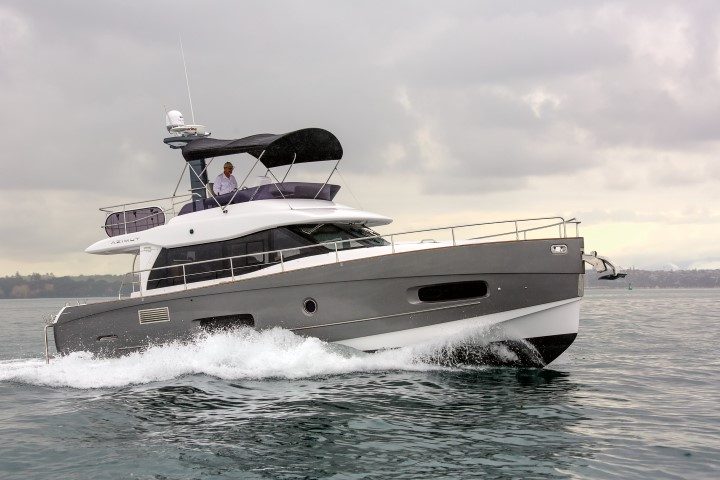
The semi-displacement hull was designed by UK-based Bill Dixon Design and is very different to the typical warped-V planing hull.
A plumb bow provides a fairly fine entry at the waterline with a deepish, U-shaped chest below, flattening off in the aft sections to prevent squatting at speed. Deep spray rails are an obvious feature, sitting well above the waterline at the bow and, entering the water about three metres aft, they continue to the transom underwater.
As well as providing additional beam to support the boat’s displacement, the rails help keep the spray down at speed and add stability at rest. Twin propellers and rudders are mounted right aft in shallow tunnels, with a modest keel along the centre line.
Underway
Underway the Magellano feels stately and there’s no mistaking its hefty displacement. While the hydraulically controlled twin rudders provide beautifully-light steering at all speeds, at speeds under six knots the rudder response is woolly. I found manoeuvring at low speeds considerably more positive when I used the twin engines in conjunction with the wheel.
In fact, with rudder midships the boat can be turned 360o in less than one and a half boat lengths by using one engine slow ahead, the other slow astern. Add the bow thruster to the equation and the boat can be walked around 360o on the spot. At speeds over six knots the response from the wheel steering improves markedly and even at full speed remains effortless.
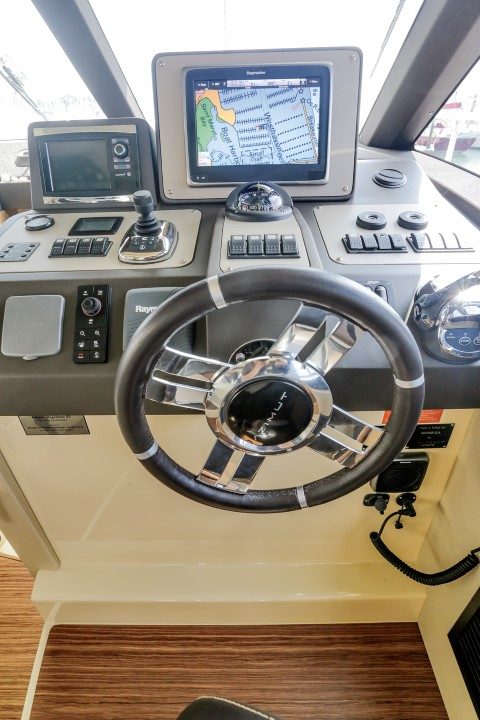
Travelling within the Waitemata speed restricted zone at 10 knots proved extremely comfortable, the boat sitting back slightly onto her aft hull sections and any wakes were simply bunted aside.
Once into the outer harbour, the boat proved equally happy between 14 and 18 knots. Thanks to the aft-mounted engines and excellent soundproofing the noise levels remain low. Good visibility, easy steering, a comfortable helm seat and a decent-sized chartplotter make the skipper’s job an easy one.
Engine revs, fuel consumption, speed and range reveal an interesting trait. Between 1,800 and 2,200rpm, equating to 11 and 16 knots respectively, the range only varies by five nautical miles. This means the skipper can cruise anywhere between these speeds and the litres-per-nautical mile figures will remain virtually identical.
Thanks to our flat-water test conditions, I couldn’t check the Magellano’s performance in a seaway, but Azimut claim it provides an exceptional ride in rough water and, after seeing how it munched through wakes, I’ve no reason to doubt this.
Layout
Azimut is renowned for its craftsmanship and the attention to detail was apparent from the moment I stepped aboard. Naturally, quality comes at a price: this boat – with a few optional extras – costs around $1,2 million. The standard version is 100k less. Prices depend on the NZD/Euro exchange rate at the time of order. Let’s look at what you get for your money.

The Magellano has three distinct levels – flybridge, the main cabin and cockpit – and fore and aft lower levels. From the cockpit, it’s a seamless step into the main cabin, which has the galley immediately adjacent to port, with a bench and refrigeration opposite. Forward of the galley to port is the dining area around a folding table, with the lower steering station opposite.
This station, as one might expect of this class of boat, has the full range of engine and navigation information, along with controls for the bow thruster, remote anchoring, auto-helm and more. It’s all done in a tasteful, understated way matching the rest of the decor.
Going forward and down a few steps from the helm is a mini atrium with four doors giving access to three sleeping cabins and the guest bathroom. On this boat, the smallest sleeping cabin had a single berth, but it can be re-configured ex-factory as storage.
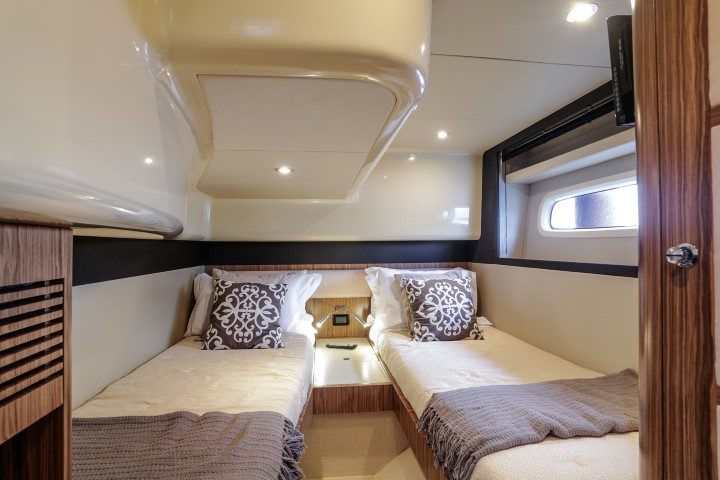
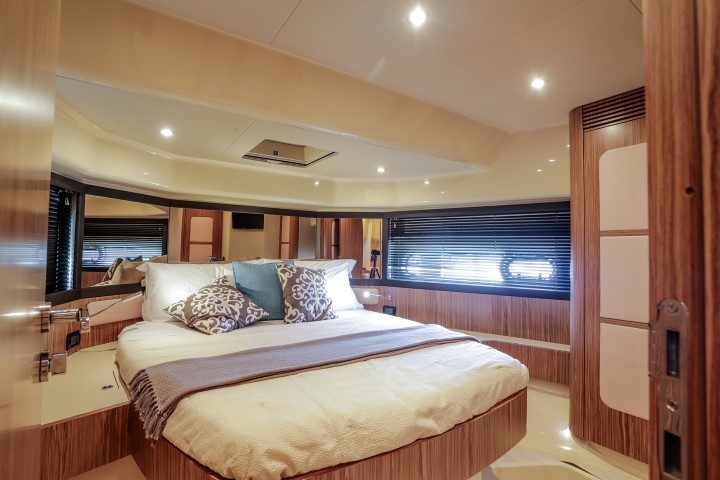
Opposite is a twin-berth guest cabin, while forward is the luxurious owner’s cabin with a substantial island berth. The adjacent ensuite is accessed rearwards to port.
Headroom throughout the living areas was more than generous, while windows and opening ports in the topsides, plus overhead hatches gives a spacious, airy feel. There is air-conditioning throughout the boat.
As the photos show, workmanship and finish are high quality. Just a few examples of the attention to detail include the accurately-cut slots for each fork, knife and spoon, the monogramed coffee cups – each in its own holder – the padded plate storage and beautifully burnished stainless steel welding.
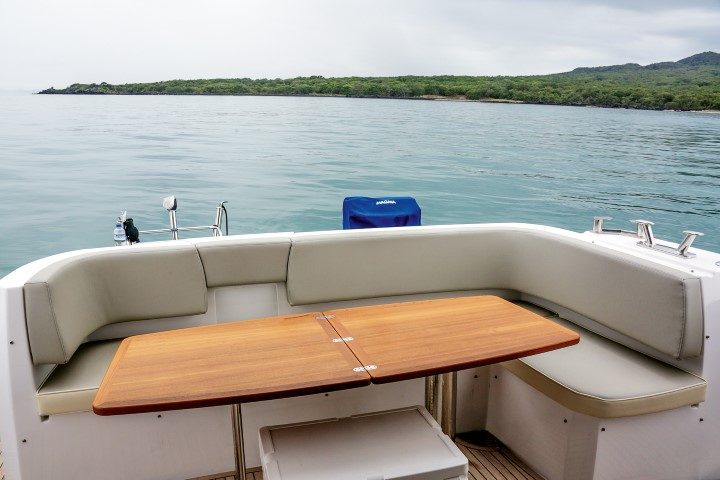
From the cockpit the foredeck is accessed either side via the side decks, which has a raised gunwale and substantial handrails for security.
Foredeck space when anchoring was generous. The anchor itself is a new generation type cast in 316 stainless. There’s also a dedicated sunbathing area on fitted squabs on the fore cabin roof.
Accessing the flybridge was easy thanks to the stairs and handrails, and once up there, a sideways hinging door can be lowered to prevent anyone taking an involuntary fall.

Uncommon in this style of boat, the flybridge is open, which to my eye makes the boat more atheistically pleasing. This also means a lower centre of gravity and less rolling at sea, while lower wind resistance aids manoeuvrability when docking. The canvas Bimini on the test boat is an optional extra.

The upper helm station was equally comfortable and had the same engine controls and instruments as the lower station. There were a couple of minor technical bugs upstairs; the chain counter hadn’t been calibrated and the upper chartplotter was seriously under reading the true boat speed – odd as the lower one was spot on.
Opposite the helm is another dedicated sunbathing platform – while aft of this is an optional grill and wet bar.
Engines
The engine room occupies the entire aft section of the hull and is accessed though a central hatch in the cockpit floor. Like everything else on the Magellano it’s beautifully laid out with considerable attention to detail.
A pair of Cummins QSB 6.7 litre, six-cylinder diesels are mounted backwards, mated to ZF 85 IV V-drive gearboxes. The V-drive configuration allows the engines to be installed well aft and still maintain a relatively shallow 12o down angle on the manganese bronze propeller shafts.
Twin aluminium fuel tanks sit outboard of the engines, with a Cummins-powered Onan 11kW generator mounted midships behind the engines. Incidentally, the boat’s supplied with 230v, 24v and 12v – depending on what’s needed where.
Aft of the generator is the hydraulic steering, with the balance of the space taken up with circuit boards, exhaust systems, raw water strainers and more.
Impressive though the engine room is, it’s fairly snug down here and I don’t envy the mechanic’s job. But it’s good that most of the basic engine maintenance can be done from here – without the mechanic having to enter the boat’s interior.
The Magellano 43 certainly isn’t your average powerboat, but for those seeking luxury boating the attention to detail and build quality will not disappoint. This is a boat that will provide gracious and refined living.
Underway, while the Magellano can travel faster, her ability to cruise comfortably and efficiently at speeds between 11 and 16 knots will be a real boon in choppy Gulf conditions.
At anchor, the restful interior, solid displacement and quality onboard systems make for luxury apartment-style living. And better than an apartment, if you don’t like the neighbours there’s always the anchor up switch.
The Magellano 43 – magnifico.[/caption]
‘Behemoth’ is a word which springs to mind or, perhaps more nautically, ‘leviathan’.
White Pointer has earned the respect of discerning customers in New Zealand and Australia, attracting a loyal and ever growing following for its high-quality, rugged and totally dependable aluminium trailer boats.
The hardtop SP635 shares the same underpinnings as the popular SF 635 which was a completely new model back in 2020.
The pride and joy of a multi-generational family, Bliss resides on a pier that’s home to a couple of other Elite motor launches – Sandspit Marina is a hot-spot for the Bill Upfold-designed vessels, with several calling this small marina home.